Shooting lines are used with shooting heads and the setup is very popular with many saltwater and salmon anglers as well as steelheaders. This article tries to cover the different types of shooting or running lines available on the market and talk about their good and bad sides.
Shooting lines are used with shooting heads and the setup is very popular with many saltwater and salmon anglers as well as steelheaders. This article tries to cover the different types of shooting or running lines available on the market and talk about their good and bad sides.
We have covered the making and use of shooting heads before, but let me just recap anyway: A shooting head setup consists of a loose head or belly and a loose running or shooting line in stead of the usual whole Weight Forward fly line where the two are made in one piece.
The shooting head is a piece of ordinary coated fly line while the running or shooting line can be all kinds of line - including a very thin, coated, level fly line.
This article will concentrate on the shooting line. For more on shooting heads, turn to our thorough articles on that subject.
Purpose
The purpose of using this type of combo is to concentrate weight as far out your fly line as possible and making the trailing line lighter and easier for the belly to pull through the eyes. This should potentially lead to longer casts with less effort.
Other reasons for using a shooting head could be to get a rig that can sink very quickly. Connecting a very heavy shooting head to a shooting line with very little buoyancy will enable the head and hence the fly to sink rapidly.
A very common purpose of a shooting line and head combination is to get flexibility. By separating the two main parts of a fly line, you can change one without exchanging the other. The most common use of this ability is to bring many heads for one shooting line. That will enable you to change from floating to intermediate to sinking with little effort.
Don't bet on distance
A comment on distance and shooting heads, just to forewarn those who think a shooting head is an easy way to long casts.
Not so!
If you want long casts, practice!
During the Danish Fly Casting Championships the winners in the distance discipline use two setups for casting. The rod is the caster's own choice in both cases, but the lines are decided by the rules: a 5-weight whole line and an 18 grams shooting head coupled to an Amnesia monofilament shooting line. The latter will typically fit a 7-8 weight rod and for some casters even a 9-weight.
So you would probably think that the heavy shooting head setup has a huge advantage.
Not so!
The longest cast with the 5-weight was 33.4 meters or 109½ feet. The longest cast with the shooting head was 33.9 meters or slightly more than 111 feet.
So half a meter or 1½ foot gained by moving from a 5-weight WF line to a 8-9 weight shooting head!
No, you don't gain much distance using a shooting head. You gain distance through timing, speed, line control and lots of practice.
But in practical fishing the shooting head setup will give you the advantage of much fewer blind casts and generally much less energy spent to reach the same distance.
Disadvantages
The disadvantage of shooting heads and shooting lines is a potentially poor presentation and poor line control.
The more extreme the difference in weight between the head and the running line, the less elegant the cast and the more difficult to get a nice turn over of the fly. In most cases this doesn't matter much--like when fishing deep--but bear in mind that distance is no great help if the casts spook all fish under the line.
Mending can also become difficult. Because of the difference in weight between the shooting line and the head, you don't have any inertia or leverage in the shooting line to transfer to the head. It's like moving a piece of chain by inducing a wave into a piece of rope attached to it. The rope will move, and the wave will run nicely along the rope, but once it hits the chain, it dies. There's too little mass and inertia in the rope to exert the chain.
Advantages
But in some kinds of fishing, these disadvantages have little influence on the fishing, mainly where you need to cast fairly far and need to cast many times to cover as much water as possible.
Many types of blind fishing in salt water is perfectly suited for shooting heads, and you will also find the largest contingent of shooting head fishers amongst those that fish for stripers and sea run trout and salmon.
Another group who benefits from the advantages and flexibility is the salmon and steelhead fishers who have to cast an oftentimes large and heavy fly on a maybe equally heavy line over as much water as possible to search a river for fish. Shooting heads are also generally well suited for different types of two hand casting.
What these anglers gain is the ability to cast with little effort and few blind casts and keep on doing so for a long time without too much strain.
I have covered most line types including shooting heads before, so let me turn to shooting lines.
What we want
A shooting line should be one or all of the following:
Light. One of the reasons for choosing a shooting head is to concentrate weight in the tip of your line setup. A lighter shooting line will help with that, and a head will also be able to pull a light line longer than a heavy one.
Smooth. Friction - or actually lack of friction - is important for the same reasons as above. If you want distance, you don't want friction. On the other hand some people prefer a little, mainly to help the tip of the line turn over.
Floating. If the line sinks it will both keep the setup from shooting as well as you want and potentially tangle with rocks and weed on the bottom - and your boots and legs! A line basket can help, but a floating line is preferable no matter what.
Without memory. Like all fly lines the shooting line should come off the reel as straight and uncoiled as possible. If it coils, it should at least be possible to stretch the line easily.
Numb. You don't want a piece of rubber band between yourself and the fly, so the shooting head and shooting line should not be too elastic. Total numbness is found in a few lines, but most have a little give.
Easy to untangle. Like any fly line, you do not want to fight bird's nests while fishing or have to untie very tight knots. But knots will inevitably form, and need to be easy to untie without leaving kinks in the line.
Easy to connect. Depending on how you connect your components you want to be able to make loops or easily tie smooth and compact knots on your line.
Supple or stiff. There are two different schools here. Some prefer a very slack, supple and soft line while others prefer a stiff, large-coiled line. Both traits are supposed to help avoid tangles and clear the line better through the eyes on your rod. Go figure!
The basic types
There are a number of basic types of shooting lines, which differ in many ways. The following section tries to describe each basic type and shed some light on the characteristics of each type.
Traditional coated
This is made like your average fly line: a braided core and some kind of coating. The line can be compared to the thin part of a traditional WF line but will often be thinner. Even so, it's still in the thick and heavy end when it comes to shooting lines, but will generally handle very well and float like a cork.
The disadvantages are mainly friction and weight, which will both give this type of shooting line a feeling, which is more like a traditional line setup. The suppleness of these lines vary with the choice of core and coating material. The braided core makes it easy to form really nice and discreet loops on the line.
Traditional coated, ridged
This line is basically made like the traditional shooting line, but the coating has been provided with some parallel grooves, which serve several purposes. First of all they help reduce friction by reducing the contact surface between the guides and the line, secondly they hold on a bit of water, which "lubricates" the line and last but not least they help retain any floatant you might have applied. They handle much like the traditional coated shooting line, and mostly have the same type of braided core making it possible to splice loops directly on the line.
Monofilament, coated
Same type of line as the two above - core and coating - but this time with a monofilament core. The mono makes the line a bit stiffer and potentially thinner and lighter, but apart from that, the coated mono feels much like the above lines.
One disadvantage of this line is that mono is often quite elastic and another is that the mono core makes it impossible to form discreet loops on the core of the line. Most monofilament lines sink, but the coating will decrease the density, and these lines tend to float.
Like most monofilament lines these lines can kink, and after untying a knot, you will often have permanent bends in the line.
GSP, coated
Another line much like the above, but in stead of nylon or a similar material for the core, these lines utilize GSP or Gel Spun Polymer, which is absolutely numb and will not stretch at all. This leaves you with a line that gives very good contact with the fly. Unfortunately the core is not well suited for loops because the individual fibers in the core are fused together in a special process, but apart from that, it does make a nice hybrid between the traditional coated lines and the coated monos with very direct contact to the fly and very little memory.
Braided, hollow
This is simply a braided line, which in many ways looks and feels like earlier time's braided Dacron backing. It's fairly thick, but light and can be made to float through material choice and treatment with a floatant. Most of the braided lines handle very well, but may hiss a bit in the guides of your rod. The line is mostly quite numb and is very supple and has absolutely no memory. The braid makes it very easy to make loops on these lines and knots and tangles untie easily.
Braided with mono core
The same as above, but with the braid spun around a monofilament core. Has many of the same traits as the hollow braided line, but is significantly stiffer due to the mono core. These lines will mostly sink a bit, but can be treated with floatant. The core also means that kinks can become almost permanent. You can make loops on these by simply removing the core on a piece, and treating it as any hollow, braided line.
Monofilament uncoated, round
This is simply a thick monofilament line. The types chosen for the purpose are low memory lines, selected to avoid coils building up in the line when it's wound on a reel. The line is typically very thin, very light and very smooth and has the best shootability of the bunch. This is the line type used by distance competition casters.
It can kink and knots can be hard to untie, and some types are also quite elastic making hooks hard to set.
All full mono lines sink. Don't let ads or marketing try to tell you something else. They sink!
Monofilament uncoated, flat
This monofilament line has been compressed to be flat, which will both reduce friction as well as keep the line straighter. Some flattened mono lines kink very easily and tend to build knots on the same, kinked spots. Apart from that they act and handle just like the ordinary mono lines.
Monofilament uncoated, ridged
Like the ridged, coated lines described above, this line also has parallel grooves which reduce friction by either holding a bit of water or by holding a floatant, which is applied while the line is dry, and stays in the grooves while you fish. If not treated with a floatant, it will sink like any mono line. The ridged mono lines are still quite uncommon.
Monofilament, hollow
Since mono is inherently sinking, some manufacturers have started making mono as a long tube, with one or several air filled chambers in the center. This type of line flows a lot better than the pure monofilament, but in most cases still needs some treatment to flow fully.
It has the handling and the shootability of the full mono line.
Shooting line types
Selecting a shooting line
If I go through my own line collection and the collections of the friends I fish with, it will soon become obvious that finding the right shooting line is absolutely no trivial task. There is no such thing as a perfect shooting line.
As if things weren't difficult enough already, there is also the matter of personal preferences and even taste - if you can use such a term in connection with a fly line. Which I think you can. One of my own shooting lines is pink, and does not get high scores with everybody for that exact reason.
For my own fishing I prefer a light, supple and numb line that has some friction and floats like a cork.
These things do not come in one single line, but the closest I have come is a hollow braided line called HT Line, which unfortunately isn't available any more. This line meets almost all my criteria, and enables me to cast reasonably far and effortless while wading without using a line basket and without too many tangles. The line has a little friction, which means nice presentations, and it handles very well. It requires floatant to stay in the surface, and I stretch and dress it every five to ten times I go fishing.
Amongst my friends I find people who use a large variety of shooting lines: round mono, coated GSP and traditional shooting lines. All have their reasons for their choice and all of us have tried dozens of different lines before finding something that (almost) satisfies us.
I still buy shooting lines to find a replacement for my beloved HT Line. Just recently I bought a hollow braided line that both coiled and sank (useless) and as this is written I have a new hollow, coated monofilament shooting line on the way from the UK as well as a coated GSP line from the US.
My line box contains about half a dozen different types of lines of which I have tried and discarded some while others never even made it to a reel or to the water.
I have HT Line for some years to come, but unfortunately these lines wear, become more and more difficult to stretch and keep floating. So one day I will run out...
Loops
When you use a shooting line and shooting head setup, you mostly want to be able to change the different components individually. Because of this, most shooting head anglers have loop-to-loop connections on all parts of their line setup: leader butt, shooting head in both ends and line end of the shooting line. That makes it interesting how easy or difficult it is to make loops on the shooting lines.
On some lines you can form really neat loops on the core or the line itself, while other types will require you to simply fold the line and securing it with some kind of glue, thread, sleeve or knot. The lines are usually too thin to accommodate the traditional braided loops used by many anglers, and on some types such a loop will not bite at all. On the mono lines a knot is the way to go. A Perfection, Surgeon's or Duncan loop is usually the most discreet knots you can make on these lines.
If loops are important to you, this may very well influence your choice of shooting line.
Stretching
One important attribute of a shooting line is that is should not coil. Since it will be piled up in a more or less messy stack - on the ground, on a boat deck, in a line basket or on the water - there's a great risk of getting tangles once you shoot line and the coils start to lift out of whatever they were resting on or in. If the line is coiled in itself, this risk is highly increased, and because of this you want the line to be as straight off the reel as possible.
Some lines--very few--offer this ability right off the spool, and you need not do anything further to stretch them, but the far majority do very well with a stretch now and then.
You can go about stretching your shooting line in two ways:
1) a full, slow, long lasting pull
2) short, brisk yanks.
The first method means suspending the line between two points and keeping it there for a longer period--like overnight. Stretch the line in its full length--maybe running back and forth a couple of times between some pegs, hooks or whatever. Pull the line very tight and weigh the tag end with something heavy, maybe simply the reel. The result will usually be a nice and straight line that won't coil for at least a couple of trips. If you use floatant, this is a good time to apply it as mentioned in the next section.
The second method consists of numerous small, strong yanks on the line, bit by bit as you take it off the reel and passes it through your hands. Grab the line with your hands 3-4 feet or a meter apart, and pull hard a few times like you wanted to break the line. Move your hands to a new piece of line, overlapping the old a bit and repeat. This method is particularly good for temporarily salvaging a coiled line while fishing.
Some braided lines "micro-curl" in strange ways and this curling is best remedied with an overnight stretch. Monofilament lines that have built up sharp kinks because of knots can be very difficult to get all straight. You can straighten them with force and maybe apply a bit of heat with the friction from your fingers, but also consider changing the line or trimming off the kinks if possible.
Like all fly lines, most shooting lines do well with an occasional rinse in mild, soapy water.
Greasing
If you want your line to float, you may want to grease it or treat it with some kind of floatant. The most common type is silicone based, like the classical Mucelin originally used for silk lines, but other substances will do. I have heard of people using things as strange as hair gel and grease for O-rings in high pressure valves.
The grease is best applied to a clean and dry line, and if you are stretching the line using the long, slow method, this is a perfect time to grease it.
After hanging the line, run a cloth with your preferred floatant over the line a few times. A dirty line or a line used in salt water can be rinsed with a damp cloth before applying the floatant. Leave the floatant on the line while it stretches and then draw it lightly through a dry cloth before spooling it the next day.
You can also grease a wet line at waterside or even in the water by running the line through a cloth with floatant, but the effect will not last as long as the dry grease method.
If your line really messes up while you are fishing, give it a long stretch while having lunch or taking a break, letting it dry and stretch between two posts, the rails on a boat or whatever is suitable. Apply fresh floatant and respool.
Who manufactures shooting lines?
Well, you can find a whole bunch of shooting lines out there, and the selection is ever changing and new products emerge as old ones disappear.
A list like the one below is bound to become obsolete before the season is over, but I'll stick out my neck and list some manufacturers and their products anyway - not least because that's what people always ask when we publish articles like this. I will also add some links, very well aware that many of them they won't even last a season or even a month. People seem to let web pages and the links to them die like flies in a window sill. But what the heck, it's better than nothing, huh?
Airflo has a Non-Stretch Miracle Shooting Braid, which is a braided line with a core. They also have a coated, ridged line, which is also available under other brands, like Scierra. For people wanting a more traditional running line there's a product called Polyfuse XT.
Amnesia is the all time classical, solid monofilament shooting line developed by Sunset. It's a 30lbs mono line originally not made for the purpose as far as I know, but has been extensively used as a shooting line and can be bough labeled shooting line. Fish USA has it, but it's fairly common.
Cortland has Used to have as of early 2015. They seem gone now and the links are dead) several traditional running lines available in different densities and thicknesses as well as a braided line simply called braided mono. They also have a flat mono line called Cobra and a flat coated braided line called Micron. The selection seems to be ever changing.
Flyfish USA is an online shop with a large selection of shooting lines.
Frog Hair markets a specially treated monofilament shooting line in several diameters prepared using their Gamma technology, which should give a stronger and more flexible line.
Gudebrod is best known for its rod wrapping thread, but also had a hollow braided shooting line simply called Gudebrod Shooting Line.
Gudebrod is closed, but some shops still have the line.
Guideline has its Shooter shooting line, which is a floating, hollow monofilament line. It's not featured on their web site, but available from some dealers.
Loop from Sweden has a couple of types.
Monic has its GSP Floating Level Shooting Line, which is a coated GSP line available in several weights and colors. It's very numb, shoots well and is and fairly easy to handle.
Rio used to call their shooting lines SlickShooter and PowerFlex, but have cut back on the selection.
Scientific Anglers has a whole bunch of traditional coated shooting lines in different densities for saltwater and freshwater use as well as a monofilament shooting line.
Varivas Airs is a Japanese brand available several places. The line is a mono line with air filled chamber. Varivas has a Japanese web site, which shows all kinds of nylon and plastic products, but the line is generally available in many flyshops.
Vision has a bunch of shooting lines and the selections seems to be changing frequently. Right now the selections is called Ace2 Running lines, but they have also had Ace Level Running line and other products. The lines are traditional coated lines, but very thin. Vision argues in favor of elastic lines by the way, and are not into the super numb type of lines.
- Log in to post comments

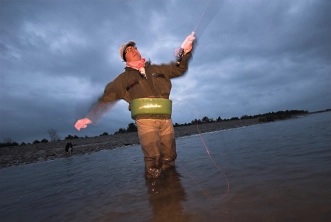
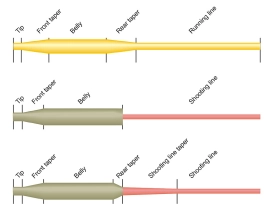
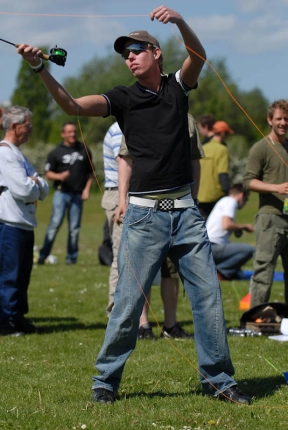
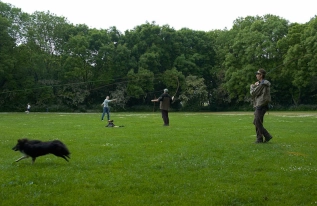


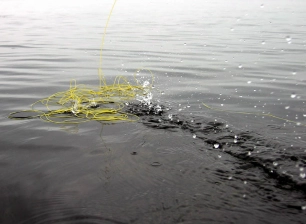

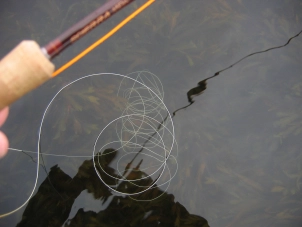


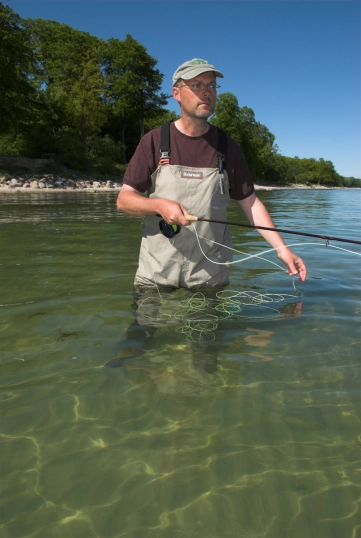
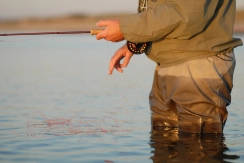

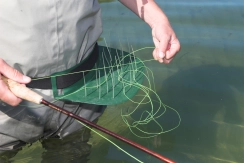

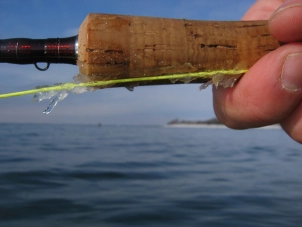
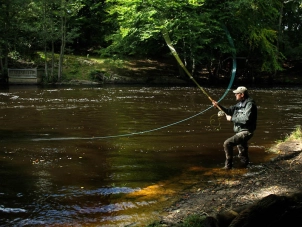



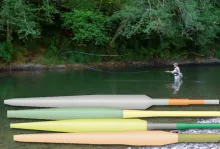



Just bought a paladi
Just bought a paladine blackhole 10 foot 6 weight switch rod. My first Spey. What line would you recomend for the flats her in queensland?
About that Redington
About that Redington Prospector - it's a two handed baby spey, the very poor man's Sage One 4116. The line weight recommendations from Redington, SA, and Rio seem to have a range of about 250-300 grains so I'm looking to start in the middle.
A sinking running line sounds like a bummer for my targets areas on the North Platte, full of submerged twigs, reeds, and rocks.
Tnx, for the prompt response and advice. I will definitely check out the link you posted.
Ian, Using a 275
Ian,
Using a 275 grain (almost 18 grams) head on a 4 wt. seems a quite heavy to me - even considering that the Skagit technique calls for heavy, short heads. When casting overhead we typically use a 14-15 grams (225 grains or so) head on a 5 or 6 wt. rod and a head for a 4 wt. would be more like 12-13 grams or around 200 grains. I would think that lifting and controlling the heavy head in a current would be difficult.
Regarding your questions:
1) Yes, the weight and surface of the shooting line is critical to the length and quality of the cast. A heavy line with too much friction can essentially prevent any shooting, especially at lower line speeds as you have when Skagit or underhand casting. On the other hand you might gain distance and shoot longer with a smooth and light line (like mono), but will have no friction to help turn over the head and present the fly.
My personal preference lies somewhere in between. I use hollow, braided shooting lines when possible.
2) The above pretty much answers this. Yes, the hollow, braided lines combine weight, friction and handling in the optimal way in my eyes. Unfortunately the good ones are few and far between. I have tried almost all of them, and my preference is a line discontinued by the manufacturer. I have tried the Airflo braided lines - they have had several different types - and while they shoot and handle well, they sink and have a tendency to kink and knot. Careful stretching and coating with a floatant can help, but never makes them perfect. Still, my guess is that a braided or a thin, coated line would be a good choice for your light setup - unless you can cope with the idiosyncrasies of mono, which can be had in almost any thickness you want. I personally dislike the lack of friction, but it might work for you as it does for a lot of people.
There's basically only one way to go, and that's trying as many as you can. Luckily a lot of them are fairly inexpensive, and you can buy a bunch a try them out until you find the one that suits you best.
You have probably seen FlyFish USA's selection, which is quite large and covers most types.
Martin
Hi Martin, This spr
Hi Martin, This spring, when the water softens up I am going to be trying to advance some Scandi and Skagit techniques for trout (Colorado/Wyoming). I have been practicing these techniques with a Redington Prospector (10'9" 4wt) using single hand lines such as SA Steelhead WF7F (also 6 & 8 versions), and distance is a bit of a fight. I'm looking to put a 250-275 grain Scandi setup on that rod and will need a running line. I have an SA .30 Ultra 4 level line that is probably a bit too heavy.
I also want develop a Scandi Head for a 5wt 9' rods to use in situations when line control is not a priority, I often like to swing soft hackles or streamers at the end of a day when my eyes are tired and the light's fading. And of course, the fish go nuts on it with enough regularity to keep it interesting. I may cut and splice a few frankenlines along the way.
Question 1: My impression is that shooting line weight and friction can have a much bigger impact on distance using ultra light spey techniques (and using those casts with single hand rods.). Comments?
Question 2: Hollow braid seems like a very attractive option. Have you tried Airflo's miracle braid? Is there another braid that has arrived on the market since your fine article that you would recommend?
Kevin,
You have m
Kevin,
You have me confused here!
You ask "What line would I use to connect a 9 weight shooting head line?"
Line to connect what? The shooting line and shooting head connect to each other. Nothing else needed.
And "shooting head line"? Is that a shooting head or a shooting line? It can't be both...
If you are asking what line to use as a shooting line for a 9 wt. shooting head, that's exactly what the article is about. It goes through all the types, and they can all be used for a 9 wt. shooting head. What to use is up to your taste and wallet.
Martin
What line would I us
What line would I use to connect a 9 weight shooting head line
Lars,
Sure a shoo
Lars,
Sure a shooting head can cast longer. There is a reason why distance casters use shooting head setups. And the wind is an important factor. I personally hate fly fishing when there's no wind. But it has to be in the right direction! If not then it's very little help--more like the opposite.
As a paradox, it seems that most fly anglers consider wind an obstacle when fishing. In a stream maybe, but in the salt it's not. A good wind will both aide your casts and give the surface some wrinkles, which will ease your fishing.
But point taken: under normal fishing conditions the shooting head will give you longer casts compared to a full line--or as I prefer it: the same distance with much, much less effort.
Martin
Hi martin,
regardin
Hi martin,
regarding distance of cast, you are correct that the distance was app. the same with shooting line and WF at the last danish championship which took place indoor but when the event has taken place outdoor and if there is some wind then the distances are longer with a margin of 3-6 meters, and we do most of our fishing outdoor ;-)
Full of condensated
Full of condensated infos as usually! I'm just looking for an overhead SH&line for Scott SHS - DH 3,2m 9# - thanks to you I've only SH to look for, thank you very much!
What a good read, ve
What a good read, very informative!